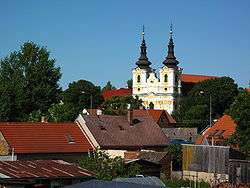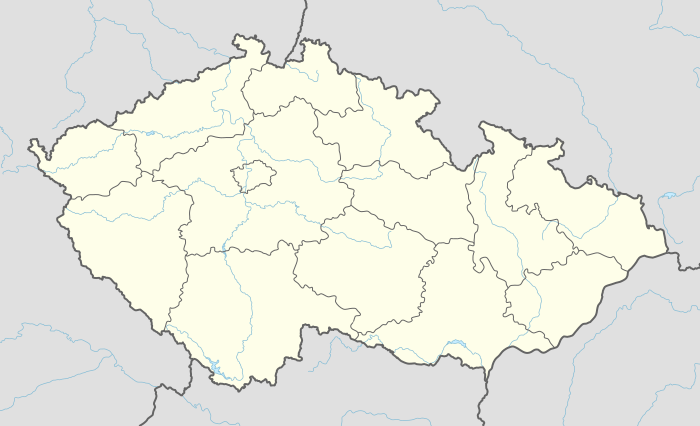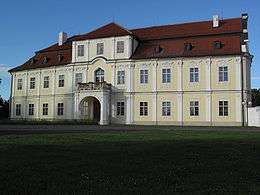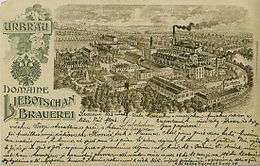Libočany
Libočany (German: Libotschan) is a village in Ústí nad Labem Region, Czech Republic. It lies near the town of Žatec on a bank of the Ohře River, by the mouth of the small tributary Liboc River. It is famous for Václav Hájek z Libočan, the most renowned Czech chronicler of Baroque times, who was probably born there.
Libočany | |
|---|---|
Village | |
 All Saints' Church | |
 Flag  Coat of arms | |
 Libočany Location in the Czech Republic | |
| Coordinates: 50°20′01″N 13°30′21″E | |
| Country | Czech Republic |
| Region | Ústí nad Labem |
| District | Louny |
| First mentioned | 1226 |
| Government | |
| • Mayor | Ivan Teuber |
| Area | |
| • Total | 5.71 km2 (2.20 sq mi) |
| Population (2019) | |
| • Total | 545 |
| • Density | 95/km2 (250/sq mi) |
| Time zone | UTC+1 (CET) |
| • Summer (DST) | UTC+2 (CEST) |
| Postal code | 43975 |
| Website | Official website |
History

First mentioned in 1226, it was on property of the Premonstratensian monastery in Doksany. Václav Karel Schroll of Schrollenberg built a new château on the site of an older stronghold with a new church and clergyman's house in Rococo style (1770). The château had a large park with statues and fountains in the back.
The church, built in 1773, is dedicated to All Saints. The vault paintings depict the scenes from lives of some patron saints. The organ was made in 1775.
Before 1918 Libočany was part of the Bohemian part of the Austrian Empire. In 1919 it became part of the newly independent Czechoslovakia. In 1938, along with the Sudetenland, it was annexed by Germany after the Munich Agreement. In 1945 it was restored to Czechoslovakia and most of its German speaking inhabitants were expelled.
Beer

The brewery from the 19th century produced beer even for US trade with a stock in New York.[1] The Liebotschaner Beer was among four Bohemian beer brands exported to the USA (the others were Pilsner Urquell, Budweiser Bier, and Michelob). The latter place, as well as Liebotschan, are located in the Saaz hops region, and bear Czech language names since 1918.[2] Several local American breweries have produced beer under the name of the former Austrian village, or abbreviated to Lieb (e.g. Chattanooga Brewing Co. in Tennessee,[3] Stegmaier Brewing Company,[4] or Lion Brewery, Inc., Wilkes-Barre in Pennsylvania;[5] Genesee's Liebotschaner Beer was pronounced best of Rochester's post repeal brews in 1932[6]
The production of beer in Libočany ended after World War I when the Austrian Empire was dissolved and Czechoslovakian authorities took over. The buildings of the brewery were demolished in 1939. After World War II, in socialist Czechoslovakia, it was replaced by a collective farm.
Notable people
- Václav Hájek z Libočan was probably born in Libočany. He wrote the Bohemian Chronicle in 1541, the most popular and widespread chronicle in the Czech lands until the 1770s.[7]
- Emanuel Wetzler was born in Libočany in 1839. He was a music editor and he published many works by Antonín Dvořák, Bedřich Smetana, and Zdeněk Fibich. He died in 1901.[1]
- Božena Viková-Kunětická (1862–1934), the first female member of the Czech diet,[8] spent her last 12 years in Libočany.[9]
- Emil Wetzler, Austrian music publisher of the 19th century
References
- "Přesměrování článků z původních stránek | Konkursní noviny" (in Czech). Konkursni-noviny.cz. Archived from the original on 24 February 2012. Retrieved 31 October 2013.
- "Brewing in Chattanooga, Tennessee". Archived from the original on 27 December 2008.
- "Keg Labels". Usbeerstuff.com. 19 August 2008. Archived from the original on 2 November 2013. Retrieved 31 October 2013.
- "American Brews- Man of 1000 Beers". Web.archive.org. 27 October 2009. Archived from the original on 27 October 2009. Retrieved 31 October 2013.
- "High Falls Brewery : History". Archived from the original on 3 June 2009.
- "Famous persons from Czech history". Czech.cz. Retrieved 31 October 2013.
- "Božena Viková-Kunětická - úspěšná žena své doby" (in Czech). Archived from the original on 3 July 2007. Retrieved 15 June 2009.
| Wikimedia Commons has media related to Libočany. |